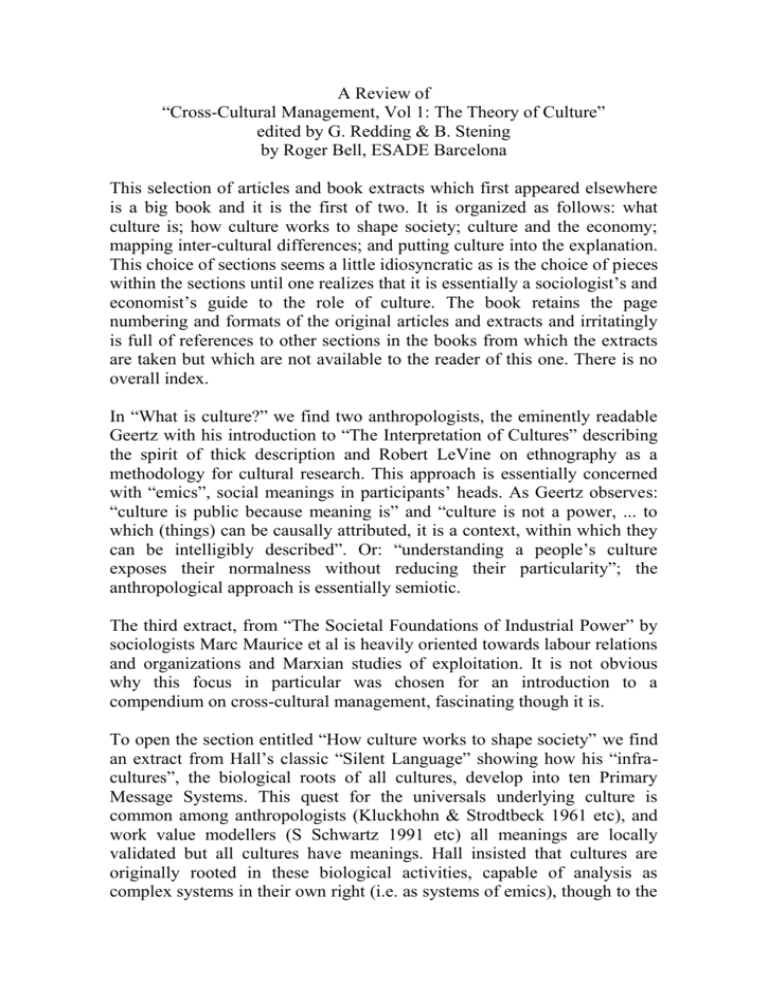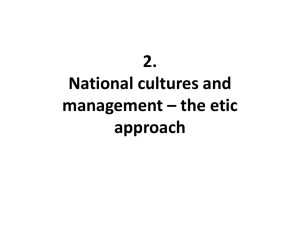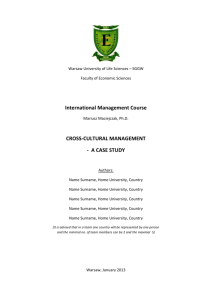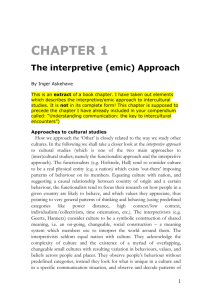Redding Stening 1 rev
advertisement

A Review of “Cross-Cultural Management, Vol 1: The Theory of Culture” edited by G. Redding & B. Stening by Roger Bell, ESADE Barcelona This selection of articles and book extracts which first appeared elsewhere is a big book and it is the first of two. It is organized as follows: what culture is; how culture works to shape society; culture and the economy; mapping inter-cultural differences; and putting culture into the explanation. This choice of sections seems a little idiosyncratic as is the choice of pieces within the sections until one realizes that it is essentially a sociologist’s and economist’s guide to the role of culture. The book retains the page numbering and formats of the original articles and extracts and irritatingly is full of references to other sections in the books from which the extracts are taken but which are not available to the reader of this one. There is no overall index. In “What is culture?” we find two anthropologists, the eminently readable Geertz with his introduction to “The Interpretation of Cultures” describing the spirit of thick description and Robert LeVine on ethnography as a methodology for cultural research. This approach is essentially concerned with “emics”, social meanings in participants’ heads. As Geertz observes: “culture is public because meaning is” and “culture is not a power, ... to which (things) can be causally attributed, it is a context, within which they can be intelligibly described”. Or: “understanding a people’s culture exposes their normalness without reducing their particularity”; the anthropological approach is essentially semiotic. The third extract, from “The Societal Foundations of Industrial Power” by sociologists Marc Maurice et al is heavily oriented towards labour relations and organizations and Marxian studies of exploitation. It is not obvious why this focus in particular was chosen for an introduction to a compendium on cross-cultural management, fascinating though it is. To open the section entitled “How culture works to shape society” we find an extract from Hall’s classic “Silent Language” showing how his “infracultures”, the biological roots of all cultures, develop into ten Primary Message Systems. This quest for the universals underlying culture is common among anthropologists (Kluckhohn & Strodtbeck 1961 etc), and work value modellers (S Schwartz 1991 etc) all meanings are locally validated but all cultures have meanings. Hall insisted that cultures are originally rooted in these biological activities, capable of analysis as complex systems in their own right (i.e. as systems of emics), though to the modern reader the account is weak on academic framework. From these roots he developed his analysis of meaning in communication. The second, widely known piece in Part II, by sociologists Berger and Luckmann (1967), though not particularly accessible, deals with the important idea of the social construction of reality: “man’s self production ... of necessity, a social enterprise” and of social order, “a human product”, manifested in institutions with varying degrees of cohesion emerging from a long process of habitualization and dialectically affecting the society that produced them. These are universals and in that sense not cultural features at all until the authors speak of “sedimentation”, as social awareness emerges and explicit awareness sinks below consciousness in individuals’ heads and actors assume roles in the institutional order. For this to be of cultural interest emphasis needs to be placed on the specific and emic nature of the experience for any given group of actors in an institutional environment. We return frequently to this theme throughout the book. The next piece, by Jean Philippe Platteau, is highly focused on trust through a variety of prisoner’s dilemma exercises that explore motivation for honest behaviour through guilt, shame or pragmatics. It is a treatise on moral norms and rather specialized for the broad topic of the book. An interesting argument is developed about whether moral norms are a prerequisite or a consequence of stable market economies, also a recurrent theme. A provocative idea: cultural norms as rules a society uses to “determine focal equilibria in game situations”, so social control. There follows an especially interesting discussion on “transplanting the market into unreceptive soils”, that is, other social contexts. As this review is written, the EU refused to recognize China as a market economy on grounds of “state interference, weak rule of law and poor corporate governance” (FT 28/6/04) as if to illustrate this. The key for Platteau is the “prevalence of abstract and impersonal relationships” and “norms of generalized morality”. Action by the state alone is not enough since the market needs to be “embedded in society” and fertile social conditions. The great majority of non-Western societies are largely governed by “the logic of traditional relations” and “entangled in tightly-knit networks of personalized relationships” “compartmentalizing the social space” and making the “abstract universality” and trust needed for markets to flourish unlikely. Islam significantly is seen as embodying “strong codes of generalized morality [that] helps build up trust within large transaction spaces”. The next extract is the chapter from Hofstede’s Cultures and Organizations: Software of the Mind on individualism (and not concerned with power distance as the editors claim in the introduction). It might be helpful to have an insight on the criteria for the selection of this particular chapter but this is not to be found in the editors’ introduction. Section three of the book deals with the impact of culture on economics. Karl Polanyi is concerned to show how traditional exchange depended on non–economic motives and that the norms of the market society are the exception rather than the norm: minimizing effort is not natural, and rewards traditionally valued throughout history have been reciprocity and reputation, not gain. Di Maggio, a difficult but rewarding writer, observes that “economic processes have an irreducible cultural component”. He distinguishes between constitutive and regulatory definitions of culture and wonders how we explain the low profile of culture in economics compared to other social sciences; he observes that “hard-wired” psychology is an easier explanatory option than culture with its “perturbations” caused by “varying schemes of perception and value”. Text analysis suggests that culture is seen to be situated outside economics: in history, in the developing world and in organizations rather than as a feature of developed market economies. He notes that for Oliver Williamson “culture is social conditioning to help assure that employees understand and are dedicated to the purposes of the firm”, which is in line with Chester Barnard. The strength of their cultures, however, may not guarantee corporations success in changing environments. Notoriously, culture tends to be used to explain others rather than ourselves, such as Japanese success in the 80s; but we should exercise caution in sorting out cultural, structural and circumstantial interpretations, a major theme of this book. Individuals “wrap themselves in shreds of culture drawn from each of the roles they occupy” as they “switch among available repertoires” and we might expect “so much heterogeneity with respect to scripts, attitudes or values as to make the very notion of culture ... too rigid to use” In any case we must “move beyond sterile generalizations” and reach for “the double understanding of ... culture as first a finite set of context-dependent orientations and second a set of rules for switching among them”. Sterling stuff. The important issue of the effect of economic change on culture is far from clear-cut; issues become entangled, but broadly marketization means “individuation, tendency to rational thought, disruption of primordial loyalties and identities (...) fluidity in human relations and new notions of freedom”. On the question of tastes, the economist’s de-contextualized approach differs profoundly from Weber and Veblen’s view. The idea also emerges of consumption as a quest for identity. Dense but worth the trouble. A classic extract from Granovetter deals with the now familiar issue of embeddedness of economic behaviour in social relations, echoing Karl Polanyi (see above) and stated more extremely by the Marxians’ economic imperatives. Granovetter sees the debate as between over and undersocialization theses, hence the famous quip that “economics is about how people make choices; sociology about how they don’t have any choices to make” (Duesenberry 1960): how autonomous is homo economicus? Culture is rather “not a once for all influence but an ongoing process continuously constructed and reconstructed during interaction” as argued elsewhere by Tony Watson (2002). Granovetter is not persuaded by the new institutional economics’ rational explanation of behaviour in terms of interest, guile and opportunism, a view which harks back to Hobbes’ Leviathan, wondering that business is so gentlemanly. We internalize the belief that peace and stability are not only the sufficient condition but the consequence of business activity. The author discusses Williamson’s market-hierarchy dichotomy in which bounded rationality and opportunism lead actors to seek the most convenient authority structure. Both organization (“hierarchy” for Williamson) and market are seen as control mechanisms which make sense of otherwise not obviously rational behaviour. Weber’s analysis of Protestantism and the spirit of capitalism is too well known to need comment but is highly relevant in this book since it emphasizes the cultural value system inspiring behaviour: not greed nor meeting basic needs, which have existed since the beginning of recorded time, but a spirit which existed before capitalism and was rooted in virtue and vocation with strong religious inspiration, in turn leading to the pragmatic utilitarian world views epitomized by Benjamin Franklin. Boisot’s linguistic elegance and erudition inform the chapter from “Information Space” (1995) on “establish(ing) culture specific institutions that contribute to the creation of a stable and meaningful order for group members”. Boisot is full of brilliant quotes; I limit myself to this one: “it would appear then that if man can escape becoming a prisoner of his material circumstances he may yet be trapped and coerced by the way he is made to construe these”. Using a cubic representation of three dimensions of information - abstraction, codification and diffusion – the I-space - he sees diversity and management producing different configurations - and he is reluctant to accept the mechanistic implications of the cultural convergence hypothesis. Cultures react in different ways: the more centripetal, closed on themselves and resisting change as has been Japan’s case, are contrasted with centrifugal cultures that “aim to exploit conflict and uncertainty constructively, making use of them as drivers of adaptive change”. Finally the emic/etic debate. By getting inside cultural meanings is one sacrificing scientific rigour and definition? Do etic observers’ dimensions reveal the truth – whoever chooses them? Boisot ironizes: “there are those that think they know - the participants – and those who really know – the observers”. He feels there is “no reason to treat emic categories as any less scientific then etic ones; ..... they may be less extensively corroborated but ...... are just as capable of approaching the truth”. In the “Mapping intercultural differences” section we first find Ronald Inglehart and his ambitious World Values Survey dealing with the persistence of traditional values in the face of changing economic conditions. The work is articulated through the two dimensions: traditional / secular rational values and survival / self expression, and presented using Huntington’s ten cultural zones, which fitted closely with Inglehart’s (1997) own map. Not surprisingly economic development turns out to correlate with both the variables. The analysis includes plots of levels of trust and GNP per head and shows the Islamic zone low on trust and income per head, the Confucian zone high on trust though not high on income and the Catholic zone low on trust even where high on income. The historically Protestant zones are found to be high on both trust and income. This is an extensive and conscientious study that goes on to discuss religious observance and faith. The conclusions are that the modernization thesis is largely right but oversimplified. It is path-dependent and reversible and not to be thought of as Americanization: there is a high incidence of traditional values in the US for the level of economic development. Why the next section, Trompenaars and Hampden Turner’s reply to Hofstede’s criticism of their book “Riding the Waves of Culture” is included and not the original comment from Hofstede is a mystery. This reply reveals a series of defensive, loosely argued protestations which fail to address the original criticism of multi-colinearity of the “dimensions” used in the book. The response to this simple methodological fact is inappropriately dressed up as a defence of complexity in culture and the fact that clusters of features co-exist. Needless to say in interpreting culture we must take into account many epistemological approaches and use ranges of etic dimensions cautiously and in triangulation with emics and experiential approaches. The table of contrasting assumptions purports to show the dynamism of Trompenaars’ approach in contrast to the static nature of Hofstede’s. They protest too much. Hofstede himself points out his dimensions are “an abstraction that should not be taken beyond its limited area of usefulness”; culture should be approached in a multi-faceted dynamic and contextualized way, which Hofstede’s factors do not help us to do. Peterson and Smith enter the debate about using countries as culture delimiters and conclude with some surprise that Hofstede’s results were “more meaningful and more stable than we had expected”. They set out to show that ambient temperature is more culturally influential than power distance in explaining role stress and conclude that this may be a contributory factor when considering clusters of influence. No major breakthroughs here. The next section, by Osland and Bird, has a very promising name: “cultural sense making in context”. It starts by citing a number of paradoxes: Americans are individualistic but give to charity, Costa Ricans are relationship-oriented but their service workers are indifferent, Japanese high on UAI but low on detail in contracts, behaviours that reflect different dimensions and are not at all contradictory. Linear dimensions describe cultures but we must exercise caution in using them. The story about the expat progressing through layers of alternating perceptions of the differentness and the sameness of the Japanese is enlightening: an experiential learning process. It is also axiomatic that other cultural and situational variables be taken into account. People don’t behave as we expect them to for many reasons: we are confusing individual and culture-level observations, the role they are in and “value trumping”: different sets of values are called on in different circumstances. The article concludes with practical advice for teaching cultural sensitivity. In their study of leadership in Japan and America, Peterson et al. explore culture-free and culture-laden comparisons. Weiss argued “straightforward management decisions” rather than cultural differences explain high productivity in Japan, risking downplaying the cultural dimension to our cost. Circumstances, such as competitive pressure, may be significant as purely cultural phenomena: a balance of interpretation is needed. Studies have tended to be of Japanese practices and American theories, and Misumi’s performance maintenance theory is unusual in going against this current. In Japanese-owned plant in America, this has meant an ongoing learning process on many levels. Calori and Dufour in their classic analysis of European management style conclude that whilst there are major sub-sets of European styles such as Latin, Germanic and Scandinavian, one can talk meaningfully of a European model significantly different from the American or Japanese ones. This model is characterized by greater orientation to people and more personalized management, more organized interests such as labour and internal negotiation in organizations, less short-term decision-making and more awareness of cultural and diversity issues. Europeans are seen as less individualistic and more loyal to their companies. A projection into the future is that regional block differences can be expected to lose force and differences between the best and the mediocre become crucial, “wherever they come from”. In the final section, “Putting culture into the explanation”, Redding is concerned with the relationship between cultural analysis and organizational behaviour. Inspired by Triandis, he encourages research that minimizes American assumptions and fits into a more global model, a plea that has not been responded to so far. The problems facing research are summarized using two dimensions: micro to universal and interpretive to positivist description. Almost all Western research is descriptive and idiographic, that is, has no universal reach and little concern for meanings and ethnography. Economic approaches have no claim to deal with meanings and familiar writers in the OB organizations field such as Adler, Hofstede, Laurent, Boisot and Child are in a central region; anthropologists such as Geertz and Hall and sociologists such as Berger and Luckmann are in the area high on both measures according to Redding. Accepting that the sociological perspective offers so much insight to participant meanings is not intuitively a very obvious conclusion. The study founders ultimately in the paradox of comparisons of systems of meanings, bi-lateral emics if you will: as Geertz points out, “ the tension between .... the need to grasp and analyze is .... essentially irremovable”. The dilemma of social science and its necessary differences from natural sciences are once again raised here. The former is different in purpose being interpretive and dealing with social constructs that “vary by meaning” and are value laden. The positivist paradigm cannot apply. We are required to accept “non-closure” of systems and use several different perspectives to understand phenomena: in a word, triangulation. Redding concludes by recommending various fusions that seek to rise above the apparently irreconcilable differences of the areas of work going on. A little pious and not altogether convincing. In the last section of the book, John Child builds on Redding, dealing essentially with the same frustrations of bringing together diverse and fragmented approaches to culture in organizations and seeking conceptual consistency and operational synthesis. The quest is still for valid instruments and concepts to make cross-cultural comparisons, made more complex because the field has concerned itself with both “cross-national studies of organization and the study of cross-national organizations”. In a novel use of the terms “high” and “low context”, Child contrasts universalist approaches that do not take national “rationales” into account as low context. This focus sees “operational contingencies that establish a functional imperative” and favours convergence hypotheses and universal theories: culture is not then a determinant. “High context” theoretical perspectives “posit national uniqueness” ascribed to “specifically national properties of a culture”. Low context approaches, he suggests, play down culture and context but run into “serious problems when (they) address(es) so-called higher order needs” (as in motivation theory), which are “primarily subject to social definition”: supposedly universal theories turn out to be heavily culture-bound. We are dealing, in Kluckhohn’s phrase, with “conditional absolutes”. Using concepts and equivalent operational measures “derived from only one culture” sums up the dilemma of the etic dimensions approach: it is the question of “conceptual equivalence”. Child concludes that we still do not have “an adequate theory on the relevance of culture for organization”. Can culture be regarded as an independent variable? In reality, it is a phenomenon with antecedents and consequences, part of a complex whole constantly moulded by external pressures of economic, technological and institutional pressures. He quotes the Chinese case in which “transactional order rests on social obligations to higher authority and community”, a tradition brought down from the Tang dynasty rather than on rules oriented to protecting the individual: “social structures and processes ... (are) historically embedded”. The institutional view seems to show a way forward integrating cultural, contextual, economic and institutional factors. Weber’s model incorporated systems of ideas, economic/technological systems and social institutions as significant inputs, offering “antidotes against the temptation to ascribe explanatory primacy to any one theoretical perspective” and against “the fallacy of regarding culture as immutable”. Child believes that conceptual consistency and a framework that synthesizes “partial sometimes narrow perspectives” are the way forward, essentially the same conclusion as Redding. I look forward to reviewing the second part of this compendium: “Managing Cultural Differences”. Roger Bell 16th July 2004









